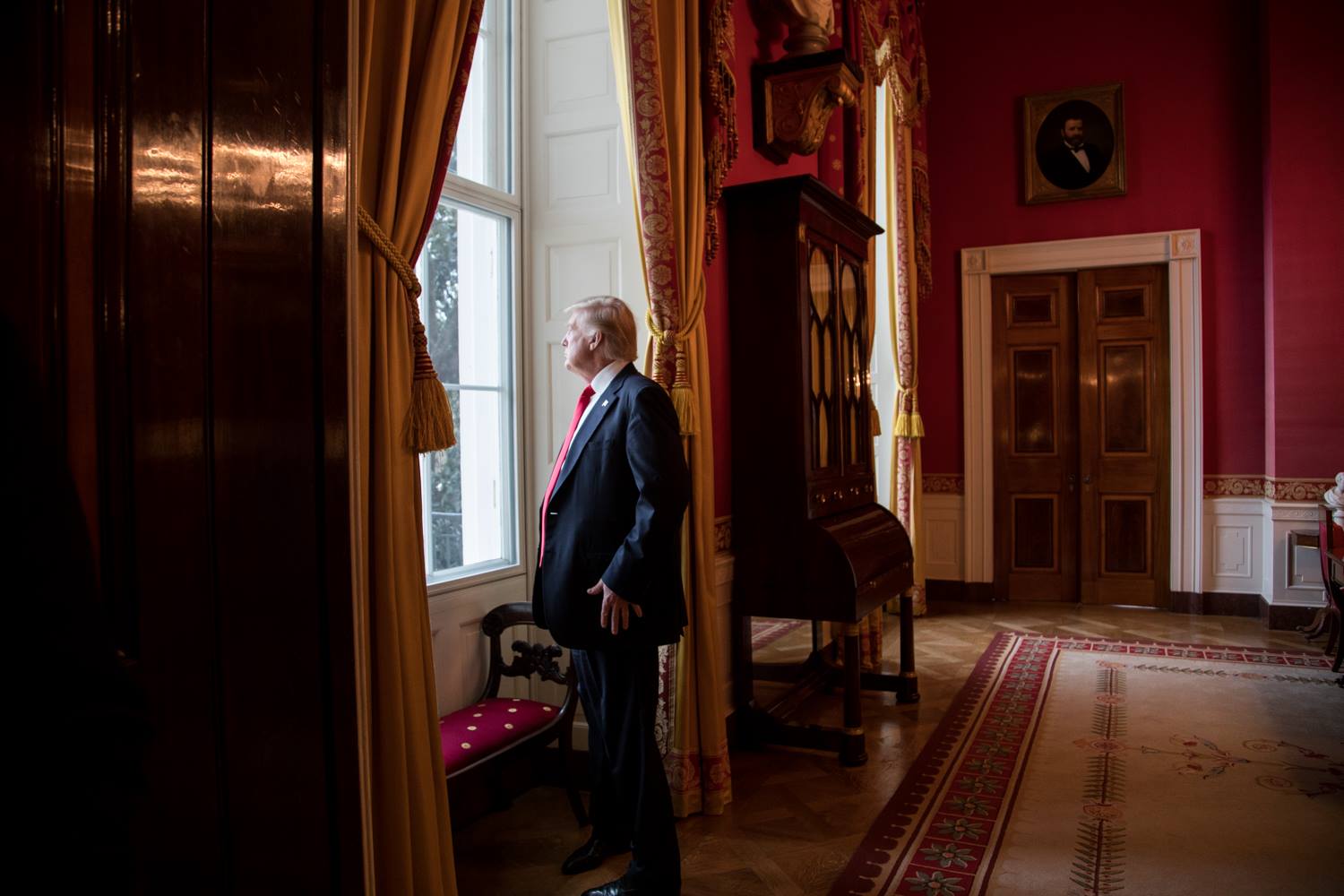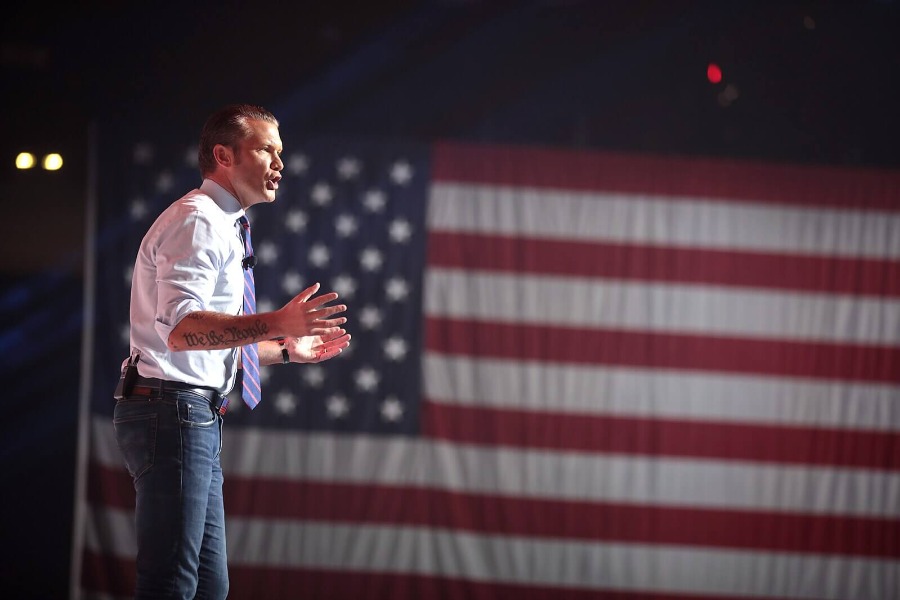Body Double: What Medieval Executive Theory Tells Us About Trump’s Twitter Accounts
In 1571, an English jurist named Edmund Plowden, trying to make sense of cases involving the sale and purchase of land owned by various monarchs, argued:
[T]he King has in him two Bodies, viz., a Body natural, and a Body politic. His Body natural (if it be considered in itself) is a Body mortal … But his Body politic is a Body that cannot be seen or handled, consisting of Policy and Government, and constituted for the Direction of the People. . . .

Published by The Lawfare Institute
in Cooperation With

In 1571, an English jurist named Edmund Plowden, trying to make sense of cases involving the sale and purchase of land owned by various monarchs, argued:
[T]he King has in him two Bodies, viz., a Body natural, and a Body politic. His Body natural (if it be considered in itself) is a Body mortal … But his Body politic is a Body that cannot be seen or handled, consisting of Policy and Government, and constituted for the Direction of the People. . . .
Plowden’s evocative phrasing would become famous in modern times because of the work of one Ernst Kantorowicz, a mid-twentieth-century medieval historian who named a seminal study of the medieval attitude toward the person of the monarch after the concept of “The King’s Two Bodies.” Kantorowicz’s book, a sprawling and ambitious text chronicling the developing “medieval political theology” of monarchical succession and the creation of the modern state, takes as its starting point Plowden’s distinction between the king’s mortal “body Natural” and his eternal “body Politic.” The former is human; the latter is an immortal entity constituting the quasi-spiritual essence of monarchical authority and the state itself. While the king’s body natural ages and dies, the body politic continues onward as the doubled self of his successors.
Among other sources, Kantorowicz draws heavily on Shakespeare, whose Richard II and Henry V dramatize each monarch’s struggle with his human fragility in the face of a divine task. The night before the battle of Agincourt, Henry V ponders that, “all [of the King’s] senses have but human conditions: his ceremonies laid by, in his nakedness he appears but a man; and though his affections are higher mounted than ours, yet, when they stoop, they stoop with the like wing.”
The astute reader will instinctively see what I’m driving at here: President Trump’s two Twitter accounts. Indeed, I want to propose here almost entirely with a straight face that the relationship between the @POTUS and @realDonaldTrump accounts is the new manifestation of a very old dynamic. That is, the distinction between @POTUS and @realDonaldTrump is the distinction between the office and the person who fills it, what we might call the President’s “Twitter politic” and his “Twitter natural.”
Because in the moment that Donald Trump stood before the nation and swore the oath of office on January 20th, he quietly gained control not merely of the nuclear football, but of that other most crucial of tools in the presidential arsenal: the @POTUS Twitter account. Under the terms of the Obama administration’s “Digital Transition” plan—yes, there really was a Digital Transition plan—President Obama’s official tweets migrated to @POTUS44, while @POTUS itself was wiped clean for the next administration’s use. And it is also a matter of public record that the President of the United States—an aggressive and insatiable Twitter user—has continued to post from his preexisting personal account: the @realDonaldTrump feed.
We live in strange times.
We don’t normally conceptualize the President as having two bodies, as medieval thinkers once did of the English king, but constitutional democracy’s emphasis on institutional over individual power and legitimacy still echoes Kantorowicz’s description. This is what undergirds the distinction between suing a government officer in his or her personal, versus official, capacity. And with respect to the President, in particular, it is what undergirds the Supreme Court’s decision in Clinton v. Jones denying the President immunity for, as the Court puts it, “the unofficial conduct of the individual who happens to be the President.”
In this sense, the concept of “the president’s two bodies” is by no means specific to the Trump administration. But President Trump’s two Twitter accounts provide an ongoing, real-time dramatization of the idea. @POTUS is a digital metonym for the office of the Presidency: a vessel filled in turn by each new occupant. The account came to be Trump’s on his assumption of the office. And it will presumably not follow him when he leaves it. @realDonaldTrump, by contrast, is an unusually intimate look into the very personal preoccupations and anxieties of the man who sits behind the desk, many (if not most) of them disconnected from the work of governing and official business in any sense that we would have previously understood. His possession of this account long predates his presidency, and he uses it for everything from official statements to television reviews, media criticism, and overly-capitalized intensifiers. SAD!
Trump has, in his brief 95 days in office, succeeded in blurring the distinction between the office of the Presidency in general and the fact of his presidency in particular. But ironically, his pattern of behaving in a manner inconsistent with the dignity of the office—recall that at his first public appearance following his inauguration, he stood in front of the CIA’s Memorial Wall, lied about the number of people who had attended the previous day’s inaugural ceremony, and whined about press coverage of the crowd—heightens the contrast between the weakness and humanity of the President’s body natural and the abstract majesty of the body politic. Hence the constant confusion over whether or not Trump is “acting presidential” and what that would mean.
The whiplash is visibly confusing other actors in their interaction with the presidency. The Supreme Court justices in the Youngstown steel seizure case faced the question of the emergency authority of the President of the United States, not of the person of Harry S. Truman. By contrast, the rulings of federal judges in the travel ban cases are inextricably tied to the person and personal behavior of Donald Trump.
The Twitter natural and the Twitter politic dramatize these tensions every day. How are we to understand the President’s tweets from his @realDonaldTrump account versus his @POTUS account? Is the dividing line as clean as I’ve portrayed it above, with tweets from the former being “unofficial” and from the latter being “official,” or is the reality more complex? Legally speaking, is a tweet from @realDonaldTrump, the personal account, covered by the presidential immunity articulated by the Supreme Court in Nixon v. Fitzgerald? Ought policymakers in the executive branch take tweets from both accounts seriously as guidance, or only from the one? Or, as they often seem to, from neither?
@POTUS is clearly an official government account. It mostly tweets out press releases, links to speeches and press conferences, and photographs of the President meeting with dignitaries or otherwise at work in the Oval Office. The account description also indicates that the bulk of the tweets are sent by Dan Scavino, Trump’s Director of Social Media; tweets written by the President are signed with his initials and are relatively far and few between.
In contrast, Trump registered @realDonaldTrump in March 2009 and began using it to tweet in his capacity as a private citizen starting that May. The personal nature of the account became somewhat complicated over the course of the 2016 presidential race, during which the feed regularly promoted campaign events and began to feature tweets that appeared to be from authors other than Trump himself. These lacked his customary flair and originated from devices other than the candidate’s Android phone. While the account stopped tweeting from Android devices in March—likely a result of the President having finally been separated from his insecure phone—efforts to sift out tweets sent by Trump himself from tweets sent by his more tactful aides still represent a cottage industry. But when @realDonaldTrump broadcasts a tweetstorm accusing President Obama of “tapping his wires,” there’s no doubt what person sent out the message.
Adding to the confusion, the President’s two bodies sometimes tweet or retweet the same or similar messages—as in the case of Melania Trump’s tweet promoting the annual Easter Egg Roll, which both @POTUS and @realDonaldTrump retweeted, and Trump’s weekly address, which @POTUS invariably promotes with the occasional support of @realDonaldTrump. Similarly, sometimes @POTUS will retweet messages originally sent out by @realDonaldTrump.
And then there’s the small matter of the President’s Instagram account. Unlike President Obama, the annals of whose administration were dutifully chronicled by photographer Pete Souza on the White House Flickr page, President Trump has eschewed the official Flickr account in favor of the @realDonaldTrump Instagram—labeled the “Official Instagram of the 45th President of the United States,” though Trump created it for personal use in April 2013. Besides using the same name as Trump’s personal Twitter, the Instagram account routinely posts images of tweets from that Twitter account.
Notably, the @realDonaldTrump Instagram sometimes duplicates posts from @POTUS that are not also posted to the @realDonaldTrump Twitter. Sometimes, the occasion is run-of-the-mill official business, such as a photograph of Trump’s meeting with the Prime Minister of Denmark - but things can get more complicated. Consider, for example, the string of tweets sent by @POTUS in response to testimony by FBI Director James Comey and NSA Director Admiral Michael Rogers before the House Intelligence Committee: the @POTUS account posted clips of Comey’s and Rogers’ testimony along with (often misleading) captions marshaling the directors’ statements to both minimize the importance of the Russia investigation and lend support to Trump’s claim that Obama had ordered politically motivated wiretapping against him personally. The fact that these tweets appeared from the @POTUS account was itself striking, as the messages thus seemed to place the institutional power of the presidency squarely behind the accusation Trump personally had made from his @reaDonaldTrump account. But several of the tweets from @POTUS were also then posted verbatim to the @realDonaldTrump Instagram account, along with the clips of testimony in question.
Which body was saying what?
In short, the distinction between the “personal” account and the “official” account is far from a dispositive one; the King’s Two Bodies exist layered on top of one another. With that in mind, how are we to identify a tweet from the Office of the President versus a tweet from Donald Trump in his personal capacity—if there is even a difference at all?
Presidential Immunity
Amusing as this question may be, it actually does matter, across a number of different axes. I’m not talking here merely about maintaining the cognitive distinction between the statements of a person and the statement of the institutional presidency. But there are important legal implications too.
Consider the problem first in terms of its litigation implications. Delineating the scope of presidential immunity from civil suit in Fitzgerald, the Supreme Court ruled that the President enjoys absolute immunity when acting “within the ‘outer perimeter’ of his official responsibility.” Writing sixteen years later in Jones, the Court further held that Fitzgerald’s “reasoning provides no support for an immunity for unofficial conduct,” denying that “the President … has an immunity that extends beyond the scope of any action taken in an official capacity.”
Jones never considered what “unofficial conduct” undertaken by the President in office might look like, because it focused on conduct that took place before President Clinton assumed the presidency. But the Court’s arguments regarding the divisions between official and unofficial conduct in these two cases can arguably apply to behavior carried out within a president’s time in office as well. I feel confident the Trump administration will produce litigation fleshing out the boundaries of non-immune presidential conduct in office.
And the Twitter feeds might just provide the forum for that doctrinal development. Imagine that one President’s tweets were to give rise to a credible civil action against him. This is barely a hypothetical: Trump’s tweeted accusation that Barack Obama had wiretapped Trump Tower for political aims may well have been defamatory, though the former president has shown no inclination to sue. Likewise, before the inauguration, Trump regularly used @realDonaldTrump to attack people whom he perceived as having crossed him, often leading to harassment of the victim by the candidate or president-elect’s supporters. It’s not hard to imagine a situation in which a tweet of this sort by the President of the United States could potentially cross the line into tortious conduct if real harm were to result.
We’re already getting a glimmer of the mess that tweet litigation may produce. In a case currently before the U.S. District Court for the Western District of Kentucky, three protesters who allege they were attacked by Trump supporters at a March 2016 campaign rally in Louisville are suing Trump for incitement, arguing that his comment to “get ‘em [the protesters] out of here” encouraged the rally attendees to punch and shove the plaintiffs. The district court recently denied Trump’s motion to dismiss the case. Similarly, a former Apprentice contestant who claims that Trump sexually assaulted her is currently suing the President for defamation in New York state court, citing a range of public statements—including tweets—by Trump alleging that her public complaints of harassment were fabricated.
These cases are not exact analogues to tweets by either of the President’s two bodies. Both involve conduct undertaken before Trump took office, and fact that the defamation suit has been filed in state court may place it outside the scope of Jones, as the Jones Court explicitly reserved the question of whether the President could be sued in state court for a later day. The incitement case does not involve Twitter. But Trump’s habit of tweeting incendiary comments is such that it’s not hard to imagine that similar cases could emerge on both incitement and defamation grounds based on tweets by the President.
The question, then, is whether Trump’s tweets from both @POTUS and @realDonaldTrump are “within the ‘outer perimeter’ of his official responsibility” under Fitzgerald. The answer to this question is not immediately obvious. Regarding @POTUS, are all @POTUS tweets within that outer perimeter by definition, or are some tweets official and some not? Regarding @realDonaldTrump, the question is harder. When the President tweets from this account, after all, he is specifically choosing not to use the account associated with the institutional presidency but with one associated with him personally, one which predated his presidency and which he uses for all sorts of personal expression. Are all the account’s tweets outside the perimeter and therefore not immune under Jones; are all inside the perimeter and therefore immune under Fitzgerald; or is there a mix of the two? To put it another way, ought we make these determinations on the basis of each account as a whole, or tweet-by-tweet?
The first possibility—that all Trump’s tweets from either account are official action and that he is therefore immune from suit based on his posts there—seems to me unlikely. If President Trump met a visitor in the Oval Office and either attempted to “grab [her] by the pussy” or commented on his desire to do so, we likely wouldn’t think of that as an immune presidential act (though I would expect the matter to be contested in litigation). Why should the situation be any different if Trump were to, for some reason known only to him, tweet a similar comment about a woman from either @POTUS or @realDonaldTrump?
But at least some tweets—perhaps most tweets—from @POTUS clearly do constitute official presidential statements. While there is a better case to be made that all tweets from @realDonaldTrump are presumptively personal and unofficial, this also seems less than credible given the level of amalgamation between the two accounts.
So the answer may be that we will have to comb through both the king’s two Twitter accounts tweet by tweet to determine which messages are truly personal and which lie inside the “‘outer perimeter’ of ... official responsibility.” I suspect that the only way to resolve this issue may be what Justice Antonin Scalia once derided as “th'ol' ‘totality of the circumstances’ test.”
What is a Presidential Tweet?
The question of immunity aside, there’s also the nagging problem of what exactly a tweet from either of these accounts really is and what status it has in the President’s function as the nation’s chief executive. Is a tweet from either of the President’s two bodies an official statement of government policy? In fact, is it an official government statement at all?
On Friday morning, the President’s Twitter natural, the @realDonaldTrump account, tweeted the following:
Another terrorist attack in Paris. The people of France will not take much more of this. Will have a big effect on presidential election!
— Donald J. Trump (@realDonaldTrump) April 21, 2017
To further complicate matters, this tweet was later posted to the @realDonaldTrump Instagram in the form of a graphic, suggesting that someone on Trump’s staff booted up Photoshop in order to throw the post together. Did this constitute not only a formal endorsement by the White House of National Front candidate Marine Le Pen, but also of the potential effect of terrorist attacks on boosting far-right candidates as well? Or, alternately, was it just the personal musing of a man watching the morning shows? This is a question of importance not only to the government and people of France—who may want to know what U.S. policy is regarding their election—but also within the U.S. government. Is the State Department to take Trump’s tweets as official statements meant to guide policy? If so, how is it to distinguish between tweets that ought to shape policy and tweets sent in a personal capacity?
Does the United States government have a formal view, for example, of ratings on The Apprentice?
Trump’s tweets are contributing to a broader splintering of the unitary executive. Usually when the President speaks, we assume that he does so on behalf of the entire executive branch. So far, this has not proven true under the Trump presidency—a point that goes well beyond tweets. Following Turkish President Recep Tayyip Erdogan’s contested victory in a referendum widely considered to tilt the country toward authoritarian rule, the White House issued a readout of a congratulatory phone call between Trump and Erdogan, one which followed a State Department release that cautioned the Turkish government to “protect the fundamental rights and freedoms of all its citizens.” Which was the policy of the U.S. government towards Turkey?
Whatever has generated this confusion—understaffing, inexperience, or otherwise—Trump’s tweets compound it by adding into the mix the innermost thoughts of the President, broadcast out to the entire world apparently without vetting or discussion within the executive branch. And the fact that he is sometimes tweeting in his personal capacity, sometimes in his official capacity, and that nobody can tell the difference, is makes it still more acute.
This has legal implications as well. In a recent Guantanamo habeas case, for example, counsel for two detainees filed an emergency motion for their clients’ release prior to Trump’s inauguration on the basis of a January 3 @realDonaldTrump tweet declaring, “There should be no further releases from Gitmo.” Counsel for one of the petitioners further elaborated that “the incoming administration intends to end all transfers immediately”—suggesting that @realDonaldTrump tweets should be viewed as official statements of administration policy.
That motion was denied in turn by two consecutive judges, neither of whom addressed the tweet itself. But the question of whether to read @realDonaldTrump as the official position of the executive branch keeps coming up. It arose in the litigation surrounding Trump’s executive orders restricting travel from six majority-Muslim countries, for example; granting a temporary restraining order against the implementation of the revised travel ban, Judge Derrick Watson of the U.S. District Court for the District of Hawaii cited a tweet from @realDonaldTrump defending the hurried rollout of the original executive order as an effort to prevent “the ‘bad’” from “rush[ing] into our country.” Judge Watson pointed to the tweet alongside a comment by White House Press Secretary Sean Spicer as an indication of the White House’s line on the matter. Likewise, during a hearing before the U.S. District Court for the Western District of Washington, Judge James Robart noted an @realDonaldTrump tweet declaring “SEE YOU IN COURT” in response to the Justice Department’s request to postpone proceedings. To quote CNN:
As the government argued for postponement, the judge referenced Trump's tweet reacting to the 9th Circuit ruling saying he would "see you in court."
"I'm a little surprised since the President said he wanted 'to see you in court,'" Robart said, later adding, "Are you confident that's the argument you want to make?"
DOJ lawyer Michelle R. Bennett said: "Yes, your honor."
Judges Watson and Robart seem to be treating @realDonaldTrump tweets as official statements indicative of White House policy, or at least probative of it. The more controversial question, though, is whether tweets from this account are also evidence of the President’s motive in developing the travel ban—an issue that has been at the forefront of litigation on the matter, as plaintiffs argue that executive orders are tainted by Trump’s animus. While the courts have not weighed in on this yet, the Justice Department may have teed it up by arguing that only statements made by Trump after he swore his oath of office are relevant to a judicial inquiry into the purpose behind the executive orders. The Department’s point was that all of Trump’s campaign-trail declarations promising a ban on Muslims entering the United States should be off the table, but this also implies that statements made by Trump during his presidency are fair game. So if the President tweets something intemperate about the travel ban or a message suggesting animus against Muslims, perhaps we’ll learn whether the courts consider tweets—whether from @POTUS or from @realDonaldTrump—to be evidence of presidential purpose.
Then there’s the issue of the Presidential Records Act, which requires the preservation of all “documentary materials … created or received by the President … in the course of conducting activities which relate to or have an effect upon the carrying out of the constitutional, statutory, or other official or ceremonial duties of the President.” By the law’s terms, it certainly appears to include tweets: 44 U.S.C. § 2201(1) specifically notes that “digital” materials may be categorized as records. According to the National Archives and Records Administration, the President’s staff must sort the relevant materials as “Presidential records or personal records upon their creation or receipt” and file them accordingly.
So do tweets from @realDonaldTrump “relate to or have an effect upon the carrying out of the constitutional, statutory, or other official or ceremonial duties of the President” under the Presidential Records Act? And must they therefore must they be archived? Likewise, if the President were to tweet a rude personal comment from @POTUS, would this also have to be archived? Or are these just idle thoughts in his personal capacity—like the personal emails that Hillary Clinton segregated from the work-related emails she turned over to the State Department?
The status of @realDonaldTrump tweets under the Presidential Records Act has already become a problem thanks to Trump’s occasional practice of deleting tweets posted to that account. If those tweets constitute official communications under the Presidential Records Act, and if they were not independently archived by the White House, then their deletion raises compliance questions under the law. While a guidance on the White House website held over from the Obama administration states that the government “automatically archives ‘tweets’ from official White House accounts,” this would seem not to apply to @realDonaldTrump.
Two requests from Congress have done little to elucidate the situation. A March 8th letter from House Oversight and Government Reform Committee Chairman Jason Chaffetz and Ranking Member Elijah Cummings requesting information on the administration’s archiving system under the Presidential Records Act does not appear to have generated a public response from White House Counsel Don McGahn. And even Chaffetz and Cummings hedge on the question of whether all @POTUS and @realDonaldTrump tweets must be archived, writing, “Many of the messages sent from these accounts are likely to be presidential records” (emphasis added). Meanwhile, in response to a letter sent by Committee on Homeland Security and Governmental Affairs Chairman Tom Carper and Ranking Member Claire McCaskill, Archivist of the United States David Ferriero recently wrote:
Question 3: NARA considers President Trump’s tweets as presidential records that need to be preserved for historic purposes. Has NARA made a determination of whether the Trump administration must also preserve altered or deleted tweets? …
Answer: No, under the PRA, records management authority is vested in the President, and NARA does not make “determinations” with respect to whether something is or is not a Presidential record … NARA has advised the White House that it should capture and preserve all tweets that the President posts in the course of his official duties, including those that are subsequently deleted, as Presidential records, and NARA has been informed by White House officials that they are, in fact, doing so (emphasis added).
This statement essentially answers nothing at all. The Act requires archiving of tweets posted by Trump “in the course of his official duties” by definition; the question is which tweets those are. According to Ferriero, this problem appears to be up to the White House to answer. So on this point, keep an eye out for Don McGahn’s response to Chaffetz and Cummings.
It would be particularly interesting if the White House took the view that tweets from @realDonaldTrump are not official presidential records for purposes of the Act, given that plaintiffs would almost certainly cite this as a concession that @realDonaldTrump tweets are not official acts immunized by Fitzgerald.
Conclusion
On some level, we all know—and accept—that the President is not acting in his official capacity all the time. Think of all the micro-scandals that have resulted over the years from presidents’ private comments inadvertently being recorded on hot mics: President Obama once referred to Kanye West as a “jackass”; President George W. Bush called New York Times reporter Adam Clymer a “major league asshole” in a conversation with Vice President Dick Cheney. The comments themselves may have been unfortunate, and the presidents erred in ventilating them in public. But the fact of a president’s having personal opinions apart from matters of his office is part and parcel of our being governed by men, rather than angels.
The Twitter politic and the Twitter natural, however, mean that Trump’s exposure of the President’s body natural is not taking place only in instances of frailty meant to be kept away from the public eye; instead, President Trump broadcasts his private musings to the entire world.
The combination of President Trump’s habit of blurting out whatever he happens to be thinking about at the moment and his devotion to Twitter—a platform designed to maximize the number of people who receive each barbaric yawp at any given time—strips away the screen that presidents usually do their best to hold up between their public performance of leadership and their private thoughts and doubts.
The essayist and philosopher Michel de Montaigne famously wrote that, “Kings and philosophers shit.” More recently, Bob Dylan quipped that, “Even the President of the United States sometimes must have to stand naked.”
Until now, however, he has generally done so in private. But now the King chooses to display his body natural—in the form of his Twitter natural—constantly before us. The question is whether doing so will erode the distinction between his “Body mortal” and that body “that cannot be seen or handled, consisting of Policy and Government, and constituted for the Direction of the People.”





